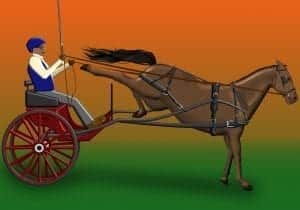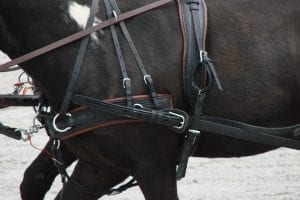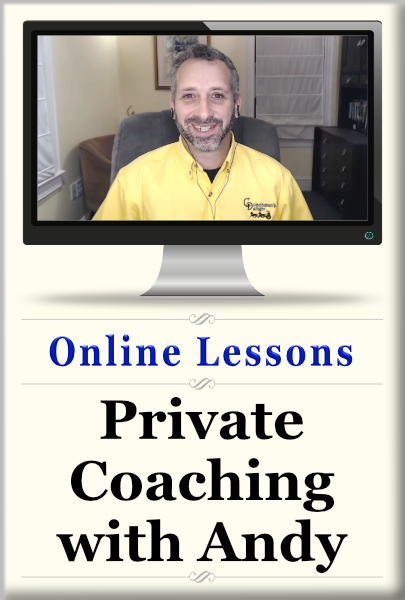What’s the Bucking Point?
 When a horse or pony bucks in a carriage, it presents a potentially dangerous situation. If the horse is able to get his hind end high enough, he can kick the carriage, or worse yet, the people in the carriage. To safeguard against that, a bucking strap can be added to the harness. However, that really doesn’t address the real problem if the horse has a habit of bucking.
When a horse or pony bucks in a carriage, it presents a potentially dangerous situation. If the horse is able to get his hind end high enough, he can kick the carriage, or worse yet, the people in the carriage. To safeguard against that, a bucking strap can be added to the harness. However, that really doesn’t address the real problem if the horse has a habit of bucking.
I get questions all the time about harness fit, and particularly how to fit bucking straps. I’m always happy to answer the questions I’m asked, but sometimes I feel like the wrong question is being asked.
Here’s the question from the “Ask Andy” page:
Hi Andy.
I have a welsh pony that bucks in the shafts. I have put a bucking strap on (and followed the pointers in your video). It’s a 2 wheeled cart (Frey Rebel) and she seems able to bounce it around and still buck. Thoughts?
My Answer:
The first thing I’ll say is that it’s a little tough to diagnose a problem from a 3 line message, so I’ll take a few liberties in my reading of it. We’ll start with a discussion on the bucking strap.
The Bucking Limiter

Checking the fit of a bucking strap.
The bucking strap is a safety device, rather than a training device. In other words, it’s there to prevent something worse from happening, but it can not teach the horse that bucking in the carriage is wrong.
The idea behind the bucking strap is to keep a horse’s buck from creating a bigger problem if the horse tries to have a buck while driving. Properly fitted and adjusted, it limits the height that the horse’s croup can rise when the horse makes an effort to buck.
That’s a good thing, because it protects you from getting kicked in the carriage. It also keeps your pony from trashing your carriage, or hurting himself by making contact with the carriage.
It many circumstances, the bucking strap will discourage a pony or horse from bucking. When the bucking strap catches the pony before he can get his hind end in the air, it kind of gives the buck a rejection knock-down. That makes is difficult, but not impossible for the pony to buck.
What the bucking strap doesn’t do, is train your pony to not buck. It’s not a training device. It’s a safety device.
If a horse is really committed to giving a buck, he’ll try to find a way to make it happen. He’ll adjust his balance so that he can still get his weight on his forehand without getting the hind end quite so high in the air. Once he does that, he can still give a nice little double-barrel kick to finish the move with a bang. The buck won’t be as high and grand as the pony would like, but he’ll get his point across.
What The Point?
Therein lies the question. Why is the pony choosing to buck in the first place?

A poor fitting, badly designed breast collar.
Horses and ponies don’t usually buck just for the heck of it. There’s usually something that made them think that bucking was a good idea. Generally, it has to do with something else that they think is a bad idea. (Although occasionally some horses do it out of exuberance.)
Bucking is a form of resistance, or lashing out. That can be in reaction to a specific activity such as riding or driving, or an outside stimulation. The menu of options for “outside stimulation” is a pretty long one.
Tack fit usually ranks pretty high on that menu. That includes everything from the bridle all the way back to the ends of the traces including how loosely or snug the pony is hitched to the carriage. Uncomfortable or painful tack is more than enough reason for a horse to buck.
Check for any rub marks, sores or hot spots everywhere on the pony. The best time to check is after a drive. If he’s sensitive to, or objects being touched in a place where the harness touches him while driving, you may be on to something.
Bit comfort is another big item on the list. If the bit doesn’t fit correctly, is too strong, or is being handled too roughly, your pony may just let you know with a buck.
Finally, the hitching could be either too tight, or too loose. If it’s really tight, or the pony never was really well trained to breeching, he could be trying to reject it.

Very loose, saggy breeching.
On the other hand, if the breeching is really loose or low, it can cause just as much trouble. In that case the pony gets an extra shove after every downward transition. It’s like having someone walking behind you, and every time you stop or slow down, they bump into you.
When you have the pony hitched to the carriage, pull the carriage back so the traces are taught. You should be able to place your hand sideways between his butt and the breeching. It can be a little snugger than that, or a little looser. Larger variations in either direction could be a problem.
What I Would Recommend
I’d say it’s time to go back to basics. Treat him as if you’re teaching him to drive again from the beginning. That means lots of ground driving and long lining.
If the bucking doesn’t show up there, you’re on the right track. Next, introduce the full harness to the ground driving and long lining. Ditch the traces, and attach the breast collar to the breeching with bungie cord. (Take the hardware off and use a Lark’s Head knot to attach it.)
You can start with that setup relatively loose, but not so loose that the harness slops all around on him when he’s trotting on the long lines. Over a couple of sessions you can tighten it up, but don’t make it restrictive.
If and when the bucking does show up, examine the conditions in which he decides that bucking is the right thing to do. He’s wrong by the way. Please feel free to chastise him for it, but also try to figure out what is leading him to it. If you can remove the stimulation that’s causing him to buck, he’ll be much happier.
By all means, have someone help with the project. A bucking pony is a dangerous prospect, so take it seriously. Working alone with a known bucker is risky business. At minimum have someone who can lend a hand while you’re working him. Better yet, get a trainer to help you. It’s worth it.
So that’s a long answer to a short question. I hope it helps. You’re welcome to ask followup questions in the moderated comment section below.







Once again … another excellent article. Thank you! I use a kicking strap on all horses I drive (green or experienced). Like wearing a seatbelt: it’s there if you need it
I have a 34” mini Shetland. He’s been driven singly, for maybe six years, which he does well when his head is on right. He has done some pairs driving, where he worked like a tractor, and was my ”old reliable, and most recently I’ve driven him as tandem leader, where he seems happy working. He has thrown in a tiny bucking episode very occasionally, which I’ve always managed to deal with, and hasn’t been a major issue, but I’ve never been able to put a reason why in place. Last year, returning from a drive, he got increasingly edgy in trot, and bucked managing to kick the carriage, which frightened him, and he took off, continuing to buck and kick the carriage, until he got his left hind over the shaft. I managed to stop him and with my husbands help, managed to drop the carriage and harness off him, and spent the next two weeks nursing his bruises. He broke the bucking strap he was wearing! Where do I go from here? Like I say, tandem leader is certainly no option, but could he ever be trusted in shafts again? I have a longer pair of shafts for the carriage….is there any point fixing them on?
Hi got cob 13.2 2hh slow if on his own needing lot pushing forward ..doesn’t like going different places.
Always looking around if out comfort.
Goes well following
He has run 3 times on road each time getting bit further.. no reason.
Has turn away from stuff 360 turn but but seem to have dtopped this. need know if he is becoming unsafe e has been with me for 6 yrs. And feel we go from one problem to another ..is it that he doesn’t like driving.. he loves going pub and falls asleep
Hi June,
It’s a little difficult to grasp just exactly what you’re dealing with by reading your comment. It sounds as if you have an issue with bolting. As with many bolters, it sounds as if it’s getting progressively worse.
That’s something you’ll certainly have to address, as well as the spooking. If it continues, it will likely get worse, and perhaps you won’t be able to drive him anymore.
I’d suggest having a look at my “Driving Past the Spook” class. There’s a lot of good coaching in that class to help address some of these issues.
I think the coaching in that class on contact may be some of the most useful portions of the class.
If I may say “Its not about removing bad behavior, its about replacing bad behavior with good ones” You tell him he doesn’t have time to do this or that… he’s to busy working on the good stuff. So if your horse is busy doing bad things its because your no keeping him busy on the good stuff. Train. Never test
I think the problem started with the shafts. She drove very nicely until one day I turned her too tight. It went to hell in a hand basket after that. I have ground driven her, harnessed her and long lined her., and she is super pony.
I have tried going back to diving her with poles dragging. But it’s a bit of a shit show every time
I have picked up shaft guards to keep the ends of the shafts (marathon shafts) from pressing against her. I am struggling to get back to the point that I can hitch her safely.
Truly, I just want to get back to a point where I can hitch her safely and try to quietly regain her confidence.
Ah, that makes sense. The shaft issue is a tough one to deal with.
I’ve never been one to make much use of ground poles. It’s a legitimate method, but it can be precarious when things get squirrelly. It’s tough to manage all that’s going on when the pony objects.
I have had success with using PVC training shafts with horses that have had this issue. My training shaft setup doesn’t drag like drag poles. They are suspended by the harness tugs, and basically a bucking strap over the croup. The training shafts are made of three separate lengths of heavy-duty 3″ pipe. They can be disassembled so that I can use one at at time. It’s a bit jury-rigged when I hang one off the harness, but on the few occasions I’ve need it, they work.
I actually start the project in the grooming area, with either a halter on, or an open bridle. It’s a matter of showing the pony what the shaft is doing, and taking the time to get her comfortable with it. Think of it sort of like getting a horse over the fear of whips.
When it comes to moving with the contraption, it’s usually a two person operation, with one leading, the other stabilizing the training shaft. We start with one at a time. Get used to one side, then work on the other.
Eventually (after a few sessions) I put the whole thing together, and once again, in the barn, push it left and right so the pony can feel that weird binding feeling. Again, out in the arena with a leader, until it’s all good enough for ground driving with the crazy contraption.
It’s a long process, but a good pony is worth it.
Hi Andy,
I go back a step further and use pool noodles as shafts. They will fit through the tugs and can either bounce in the air behind the horse (open bridle so she can see them) or be tied together behind the horse so they snug against the loins and can be moved up and down. I use two noodles for a pony and 4 – double the length for a horse ( use a string through them to keep two together in a long length). Ground drive, double lunge, open and closed bridle until there is no issue with the feel of the ‘shafts’. If they kick or get upset, the noodles cannot hurt or damage the horse (or you). Only after the pool noodle exercises are tolerated do I move to the PVC pipe shafts.
I always use a kicking strap for safety.
Good luck to lprichuk with your pony. Take your time.
That’s a great idea Gillian. Thanks for sharing!
Where does the 3rd shaft attach? I’m having a time with this ground pole issue with my horse turning and swing the shaft around that’s all connected ( 2 long one short in back)
Also coming up with a way to keep them in the harness loops on front as they drag
What do you attach the tugs to!